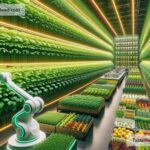The Future of Food: Building Sustainable Solutions for Tomorrow
Food is the foundation of human life, providing nourishment, energy, and joy. As the global population grows and resources become increasingly scarce, the way we produce, distribute, and consume food must evolve. The future of food is not just about feeding billions—it’s about creating a sustainable system that ensures everyone has access to healthy, affordable meals without harming the planet. Let’s explore how science, technology, and smart practices can pave the way for a better food future.
The Challenges We Face
Before we dive into future solutions, it’s important to understand the challenges facing our food systems. These include:
-
Environmental Impact: Agriculture is a major contributor to greenhouse gas emissions, deforestation, and water pollution. Industrial farming practices have degraded soils and led to biodiversity loss.
-
Food Waste: Roughly one-third of the food produced globally is wasted. This is a massive loss of resources—water, labor, and energy—that could otherwise feed millions.
-
Climate Change: Rising temperatures and unpredictable weather patterns are disrupting crop yields, making it harder for farmers to grow food in some regions.
-
Food Inequality: While some populations enjoy an abundance of food, others face hunger and malnutrition. Access to food is not equal across the world.
A Vision for the Future of Food
What does the ideal food system of the future look like? In a perfect scenario, it centers on sustainability, health, and equity. Here are key ideas that experts, scientists, and activists are working toward:
-
Zero Waste: Every morsel of food is consumed or repurposed. Food waste is minimized at every level of the supply chain, from farms to supermarkets to our kitchens.
-
Environment-Friendly Food: Crops are grown using methods that protect, rather than harm, the planet. Meat and dairy production—a leading contributor to emissions—are reimagined, with alternatives like plant-based proteins and lab-grown meat gaining popularity.
-
Global Food Access: No person goes hungry. Communities worldwide have access to nutritious meals regardless of geographical, economic, or political barriers.
-
Adaptability: Farmers are equipped with tools and techniques to grow resilient crops that thrive in the face of climate change.
Emerging Solutions
The future of food is being shaped by a combination of technology, innovation, and community-based approaches. Here are some promising developments:
1. Regenerative Agriculture
Regenerative agriculture is a way of farming that actually restores the environment by enriching the soil, protecting water sources, and improving biodiversity. Instead of depleting the land, this method works in harmony with nature. Techniques like cover cropping, reducing chemical inputs, and rotating crops help absorb carbon dioxide and make farms more sustainable in the long run.
2. Alternative Proteins
Plant-based meats, lab-grown seafood, and insect protein are part of an exciting shift toward alternative protein sources. These options use fewer resources compared to traditional animal farming while delivering the same nutritional benefits. For example, lab-grown meat is produced from animal cells in controlled environments, reducing the need for raising livestock and conserving space, water, and feed.
3. Smart Farming
Technology is revolutionizing agriculture. Smart farming uses tools like sensors, drones, and data-driven analytics to optimize crop yields. These innovations help farmers understand when and where to plant, water, or fertilize crops, reducing resource waste and increasing efficiency. Vertical farming—a method of growing crops indoors in stacked layers—also offers an exciting solution for urban areas where space is limited.
4. Community-Centered Food Systems
Local food systems empower communities to grow and share food sustainably. Urban farms, community gardens, and farmer cooperatives are boosting access to fresh, nutritious produce while reducing the distance that food travels from farm to table.
5. Reducing Food Waste
Reducing food waste is everyone’s responsibility—from farmers to companies to individuals. Businesses are developing smarter packaging to extend shelf life, while apps like Too Good To Go help people buy surplus food before it spoils. On a local level, composting wasted food instead of throwing it in the trash turns scraps into rich soil that can grow more crops.
The Role of Consumers
While governments and industries have a big role to play, consumers can also drive change in the future of food. Small lifestyle changes—such as eating more plant-based foods, buying seasonal produce, and reducing food waste—can collectively make a big impact.
Supporting local farmers, choosing sustainably sourced items, and advocating for environmentally friendly policies also help shift the system toward sustainability. By making informed food choices and holding businesses accountable, consumers can push the market in a greener direction.
Taking Action Today for Tomorrow’s Food
The future of food may seem like a distant dream, but the steps we take today will determine whether we get there. Governments need to invest in sustainable farming practices, businesses must innovate responsibly, and individuals should embrace habits that align with a better food system.
Together, we can create a world where food is not just abundant, but sustainable, nutritious, and equitable for all. Feeding the future doesn’t mean growing more food—it means growing smarter, wasting less, and putting the needs of people and the planet first. After all, the way we treat food today will shape the health of our planet and generations to come. Let’s work hand in hand toward a brighter, tastier, and greener future!


